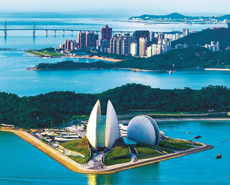
New rebar standards to boost demand for vanadium
----Interview with Sun Jian
General Manager
Jiyun Furnace Charges Co., Ltd.
General Manager
Jiyun Furnace Charges Co., Ltd.
Located in Chengdu, Sichuan, Jiyun Furnace Charges Co., Ltd. is an export-oriented vanadium processing company. Its product portfolio consists of vanadium pentoxide flake 98%min, ferrovanadium 50%min and 80%min, and its clients come from Europe, South Korea and Middle East. It has won itself a name in the vanadium industry by always keeping its product quality at a high level.
Asian Metal: Hello, Mr. Sun! Thanks for taking our interview. Would you please first give a brief introduction on your company?

Company office building
Mr. Sun: As a vanadium processing company, Jiyun Furnace Charges Co., Ltd. has been working in this industry for twenty years and our product portfolio consists of metallurgical grade vanadium pentoxide flake 98%min, ferrovanadium 50%min and 80%min. Besides long-term clients from the Chinese domestic market, we also have clients from Europe, South Korea and Middle East. We have successfully maintained a share in the international vanadium market, and our clients think highly of us for our high credit and product quality.
Asian Metal: Vanadium prices move up quickly at present, already capping the once-highest level in 2015. Is this brought about by policies or by increases in demand? Is there a gap between supply and demand in the vanadium market?

Metallurgical grade vanadium pentoxide flake
Mr. Sun: From the overall industrial perspective, price increases in 2017 could be attributed to environmental policies which clamped down on vanadium slag imports and also stemmed the disorderly business expansion of a large number of small-sized plants which extract vanadium from stone coal. In comparison, the dramatic price increases in the latter half of 2018 are driven by demand. As the new standards on rebar will go into force from November 1, steel mills need to purchase and consume ferrovanadium or vanadium nitride at least one month earlier, and so market demand is expected to grow at a very high rate. It is estimated that China will produce about 100,000t of vanadium pentoxide during the whole year of 2018, while the total demand will reach about 120,000t in 2019 according to increasing downstream demand, with the supply shortage being above 20,000t or even above 30,000t.
Asian Metal: Thanks. Supply shortage will anyway be filled. How do you think of vanadium pentoxide supply at present and quite a long period of time ahead?

Jiyun workshops
Mr. Sun: There are mainly three modes to extract vanadium pentoxide. First is to extract from vanadium titano-magnetite and vanadium pentoxide output by this mode accounts for about 90% of the national total; the second is to extract from stone coal and this output accounts for about 6%; and the last is to produce from V-contained waste materials such as catalysts, and this output is about 4%. Owing to strong downstream demand, major vanadium pentoxide producers in China (first-mode producers) are all running at full capacity now and have already been stretched to their extremes. As for the second-mode or vanadium-from-stone-coal producers, large-sized plants are close to full-capacity operation and any output increases they are able to achieve can hardly help alleviate supply shortage in the current market; while it will be difficult for small-sized and newly-built plants to form large-quantity production due to the environmental issues. And as for the third-mode or vanadium-from-waste-material producers, their outputs account for only a small proportion and therefore impose small influences upon supply status. Under such a background, vanadium supply shortage can't be effectively alleviated unless the first-mode producers build new blast furnaces. But blast furnace construction cycle usually lasts about one and a half years to two years, which is to say at least in the coming one and a half years the Chinese market will be suffering from supply shortage of vanadium pentoxide.
Asian Metal: What do you think is the reason for vanadium pentoxide prices going up? How will prices fluctuate in 2019?
Mr. Sun: Just as I said, there is a great gap between demand and supply in the current vanadium pentoxide market and accordingly prices for the material go up. And I think that this upward trend will go on for a long time ahead, but it will be hard to accurately predict at which point this upward movement will cease. Now pricing for vanadium pentoxide has completely deviated from the simple costs-plus-profits mode but instead is formed by the fact who, supplier or buyer, wins in the price tug-of-war, and the result is that actual selling prices are several times higher than production costs of the material. With market demand not receding, prices will keep going up until the gap between the two sides is fully filled. Considering the current market conditions, I am confident about vanadium pentoxide prices in China in the coming year.
Asian Metal: What measures or experience do you think can help alleviate supply shortage in the vanadium market?
Mr. Sun: There are three ways I would like to recommend.
The first is technical renovation by steel mills. Steel mills can cut their vanadium consumption by upgrading their production techniques or finding substitutes of vanadium pentoxide.
The second is that China becomes a purely vanadium importing country. China has been a purely vanadium exporting country, and if vanadium prices in the domestic market keep going up, international suppliers will be quite possibly goaded to go into the Chinese market to meet its demand. Under the current policies and economic conditions, this is possible to happen. At present, there is no direct interaction between the international and Chinese vanadium markets. One example is that during the period from June to August 2018, vanadium prices in the international market were once lower than in the Chinese market.
The third is to increase ferroniobium imports. Niobium is an important substitute of vanadium, and China's annual ferroniobium imports from Brazil are about 20,000t. If Chinese steel mills raise their niobium consumption, China's ferroniobium imports from Brazil are set to increase. In the light of existing production capacities of Brazilian producers, it will be no great problem for them to double their exports to China to 40,000t.
Asian Metal: The new standards on rebar will go into effect from November 1. What direct influences do you think this will impose upon the vanadium market?

Production process of Jiyun Furnace Charges















